
In the crypto world, success or failure is often defined by cold on-chain indicators such as TVL and transaction volume. Although they are important, they cannot touch the “human” dimension in real life.Whether it’s an exchange, a consumer wallet APP, or DeFi, behind the pursuit of data is actually the shadow of “people” in real life.How do we understand users?How do we design revenue products?How should we do marketing?Understanding the user logic behind crypto yield markets is crucial.
Therefore, we compiled the article Crypto Yield 2025 Retail Consumer Report, turning our attention from on-chain data to the real voices of retail consumers (retail investors), trying to understand how ordinary users view, trust and use yield products.Focus on the following four questions:
-
What is the underlying motivation for consumers to earn money?
-
What are the differences in trust and usage habits across different platforms?
-
What are the pain points and concerns that hinder large-scale popularization?
-
Facing 2025, what kind of revenue products do retail users want?
By restoring the story of “people”, we hope to outline the true size of the retail market and find out the next growth code for crypto earnings.

core points
Crypto yield products are rapidly gaining popularity among retail investors, but adoption is highly concentrated among centralized platforms.It is estimated that about 20 million people around the world earn income through centralized exchanges (CEX), while only about 500,000 use decentralized finance (DeFi).The huge disparity shows that mainstream users trust familiar custody platforms more, and DeFi is still only the “private place” of early geeks.
Research shows that retail investors are generally conservative and short-sighted in their income decisions:More than 60% have held crypto assets for less than a year,Only returns that are much higher than traditional financial management can make them move – 6% annualized rate is the “minimum attractiveness threshold”, and single-digit APY is hard to impress..
Trust and liquidity are the lifeblood.Nearly half of the respondents admitted that the number one reason they did not dare to get involved in income products was “fear of not being able to mention it”, followed by safety concerns and inability to understand.The ability to withdraw at any time and the protection of funds are more critical than the rate of return.When asked what features would make a revenue product “irresistible,”Flexible, instant redemption without lock-upTops the list, followed by security endorsements such as insurance or custody; the rate of return itself only ranks third.
Therefore, in order to make the cake bigger, the platform must perfect the “basic skills” that retail investors care about most.If the DeFi protocol wants to break through the circle, it must make the experience “one-click smooth” and the sense of security “visible to the naked eye.”In the final analysis, products that are easy to use, safe, and easy to deposit and withdraw will outperform those income games that only rely on high APY but are full of complicated rules and lock-ups in the long term.
1. Market size of retail investor income
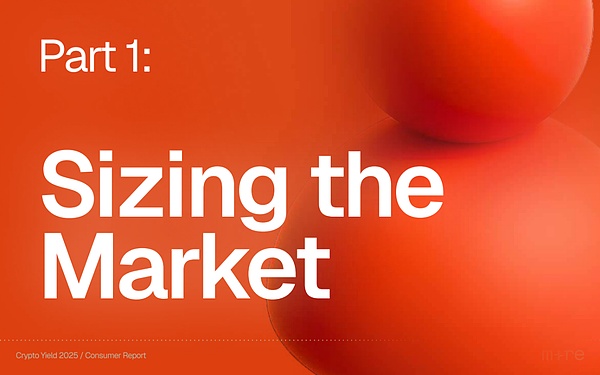
On-chain metrics such as TVL and transaction volume can track the flow of funds, but they cannot tell “how many people” are participating – these numbers are often distorted by whales, circular flows and custodians.Ultimately, the unit of measurement adopted is “people,” not “assets.”This section will estimate the scale of retail user participation in crypto earnings.
We do not seek precise head counts (which cannot be achieved on the chain), but give a credible order of magnitude range: combining questionnaires, platform disclosures and market benchmarks, we estimate the number of retail investors who “actively earn income” in CEX, DeFi and various custody products.
Only by looking at the market with “number of users” instead of “amount of funds” can we restore the real reachable space, predict the adoption curve, and provide a basis for product, compliance and GTM decisions, so that the strategy can be rooted in consumer behavior rather than abstract capital flows.
We also estimated the total number of “profit users” in the two tracks of centralized exchanges (CEX) and decentralized finance (DeFi) to show the scale of retail investors currently using value-added products such as staking and financial management.
1.1 Estimating CEX revenue user base
We take a conservative approach to measuring how many centralized exchange (CEX) users actually participate in yield, staking or “earn money” products.In reality, the true adoption rate may be higher,Various data show that the penetration rate of major platforms is about 20% to 25% (or even higher).
Let’s look at Binance first. Binance’s own survey of 27,000 users showed that about 25% of users “actively use” Binance Earn, suggesting that a quarter of its users participate in income products; while the independent CryptoQuant 2024 industry survey found that 28% of crypto users have used exchange “earn money” products.Out of caution, we lowered the range to 10–15%, acknowledging that actual participation on some exchanges is significantly higher.
Scale background: Binance announced at the end of 2024 that the number of registered accounts worldwide will exceed 250 million.Even if only 10% use coin-earning products, the number of users will reach 25 million; if the penetration rate is 25%, it will exceed 50 million.
Conclusion: It is reasonable to estimate that about 20–30% of Binance’s active users are using it to earn coins (consistent with the 25% survey result), that is, tens of millions of users are earning profits.
Secondly, Coinbase’s financial report provides hard evidence of user staking participation.As of 2023 Q4, the crypto assets actively pledged by Coinbase customers reached US$9.4 billion (retail side), including institutional pledges.In total, Coinbase customers received more than $440 million in staking rewards in 2022, which the company noted was equivalent to approximately 20% of trading revenue that year, underscoring the popularity of staking among users.
User Engagement: By early 2023, over 3.5 million Coinbase customers had joined the staking rewards program.
Scale background: Coinbase will have 120 million monthly active users in 2025.
Conclusion: At Coinbase, about a quarter of active users have used the staking/yield feature (millions of users), indicating a single-digit percentage in terms of total registered users, but a significantly higher share among the active population.
Finally, the top five exchanges ranked by the number of publicly registered users: Binance, Coinbase, Crypto.com, KuCoin and OKX.Public data shows that the total number of registered accounts on the five exchanges exceeds 500 million.However, a large number of users repeatedly opened accounts on multiple platforms, leading to falsely high numbers.In order to arrive at a realistic “real person” base, we adopt conservative adjustments: assuming that duplicate accounts account for about 55–60%, we calculate that the number of unique users of the five major exchanges is about 200–230 million.
Based on the above, the real users of the top five centralized exchanges (after deduplication) are about 200-230 million.Within this base,It is conservatively estimated that 20-34 million people (accounting for 10-15%) are actively using value-added products such as staking and financial management.

1.2 Estimating DeFi revenue user base
In order to see clearly the main battlefield of current DeFi activities, we focused on the top five “profitable” protocols sorted by TVL (covering staking, lending, and liquidity mining).Although there are hundreds of high-profile projects on the market, these five companies have captured most of the funds and participants, enough to provide reliable estimates of orders of magnitude.
To avoid confusion, we exclude assets endorsed by exchanges such as Binance’s pledge of ETH and focus on purely on-chain DeFi scenarios.The selected snapshot date is August 25, 2025, which is representative of recent user distribution and serves as a baseline for deriving DeFi revenue audiences.
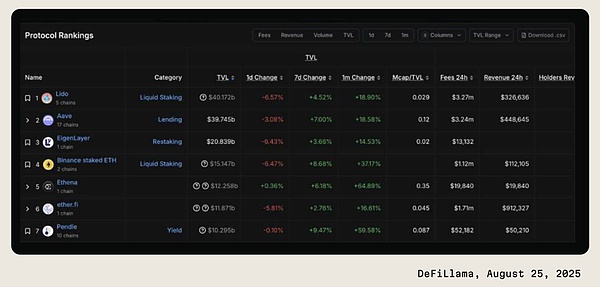
We locked the top five protocols in DeFi Llama in order of TVL, and used public data sources to count the number of user addresses in each.Since there is no unified standard on the chain for accurate deduplication, we only rely on available public information to make approximate estimates.
After integrating the five major agreements,It is concluded that the total audience of DeFi revenue is about 500,000-700,000 unique users..Theoretically, it is possible to further cross-reference the address overlap, but for this report, there is no additional value in being accurate to single digits, and the order of magnitude perspective is sufficient.

1.3 Overall picture of crypto earnings
Based on official exchange disclosures, platform data and conservative penetration rate assumptions, we estimate:
-
More than 20 million people in centralized exchanges (CEX) have used Earn or staking products;
-
There are only about 500,000 independent users on the decentralized finance (DeFi) side participating in staking, lending, and liquidity mining.
The exact numbers may change with market fluctuations, but the difference in magnitude is clear: CEX hosts tens of millions of profitable users, and DeFi remains in the niche stage of early adopters.
2. Market Insights into Retail Investors’ Income

Knowing “how many people” is only the first half, the second half is “what do they want”.Market size presents opportunities, and consumer preferences determine whether opportunities can be realized.
Retail adoption depends more on human nature than protocol design: motivations, trust, day-to-day trade-offs.Why did you decide to use revenue products?How do you trust your money is safe?How much reward is worth the risk?Answers can only come from listening directly to users.
This section dissects the psychology of users when facing returns: motivations, trust signals, platform preferences, obstacles, risk tolerance, return expectations, and the way of expression that can best lower the cognitive threshold.These dynamics determine the growth ceiling – only when the product is aligned with real demand can the user scale change from “potential” to “stock”.
2.1 Market research
This survey is aimed at the general retail population in the United States, ranging in age from 18 to 99 years old, covering all income levels.Among the 150 valid samples, about two-thirds (67%) have held and used crypto assets, and one-third (33%) have never been exposed.To ensure that the conclusions focus on “real behavior”, we only conduct in-depth analysis on the 101 active currency holders who have “been in the circle” to eliminate zero experience noise.
The Motley Fool’s “2025 Cryptocurrency Investor Trends Survey” shows that about 21% of U.S. adults hold cryptocurrency, and the penetration rate of segments such as Millennials and Generation Z is between 20% and 30%, which is regarded as a reliable reference for the national market.
This report is not intended to estimate the “penetration rate of currency holdings in the United States”, but to describe the real behavior and pain points of “retail investors who already hold currency” on income products.The proportion of the sample who have had encryption experience is significantly higher than the national level, which ensures that the conclusion focuses on the user experience “within the active retail ecosystem” and is more instructive for grasping product-market fit.
This sample forms a basic portrait of mainstream daily users in 2025 and can be used to observe the real behaviors, preferences and pain points of retail consumers when facing crypto-income products.The sample presents a typical “encrypted portrait” in terms of age, income and technology acceptance: young, proficient in digital tools, and mainly middle- and high-income groups, and their proportions are higher than the overall level in the United States.Precisely because this group of people is the most active segment in the current crypto market and most willing to try early-stage revenue-generating products, observing their motivations, pain points, and preferences can directly map the real needs and future trends of the retail side.

This survey only focuses on the five assets with the highest retail investor holdings, rather than listing long-tail tokens.The benefits of doing this are:
-
Insights are clearer, more statistically significant, and directly map to where retail revenue behavior actually occurs;
-
Shortening the questionnaire options can reduce respondent recall bias and eliminate the noise caused by very few token holdings;
-
Yield tools, liquidity and infrastructure are the most mature among the top five assets, and the conclusions drawn are the most enforceable.
These five top assets account for the vast majority of retail positions and trading volume, and are therefore also where income decisions are most concentrated.
2.2 Holding cycle
Most respondents have a short holding period for crypto assets:
-
exceed60%of people typically sell or transfer assets within a year;
-
Only a very small number of people have held it for more than three years, indicating that “long-term currency hoarding” is not common among this retail sample.
Although the industry often emphasizes the “four-year cycle” and advocates long-term holdings, data shows that ordinary retail investors do not follow this strategy.On the contrary,Short-term thinking and frequent position adjustments are the mainstream, further confirming that they regard crypto assets as a speculative tool rather than a long-term allocation.
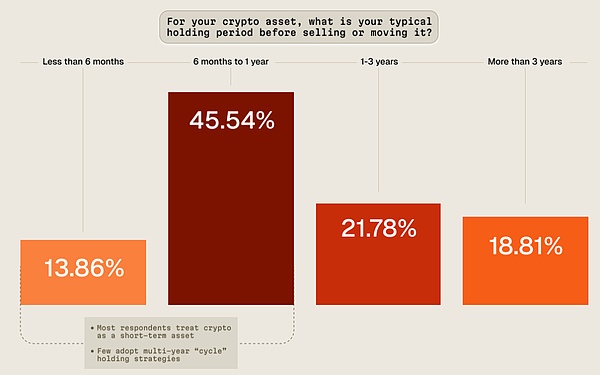
2.3 Dismantling the motivations for “earning coins”
For most retail currency holders,Earnings are considered a passive income, but the premise is that the APY must be “enough”.In other words, as long as the interest rate is attractive, they feel that their coins are “moving bricks”, even if they have no time for short-term trading.
For those who are firmly bullish on their holdings, gains have another psychological effect: they provide a reason not to sell.By staking or depositing tokens to earn interest, they can hold on to them with peace of mind in a bear market and turn originally idle tokens into “materials of production”, thereby strengthening their confidence in long-term holdings.
At the same time, airdrops, points, task rewards, etc.“Crypto-native” gameplay is of little interest to retail users.Mainstream users are not as keen on chasing these incentives as the players in the circle. Their motivations are more pragmatic – they want cash flow and account discipline, not ecological gimmicks.
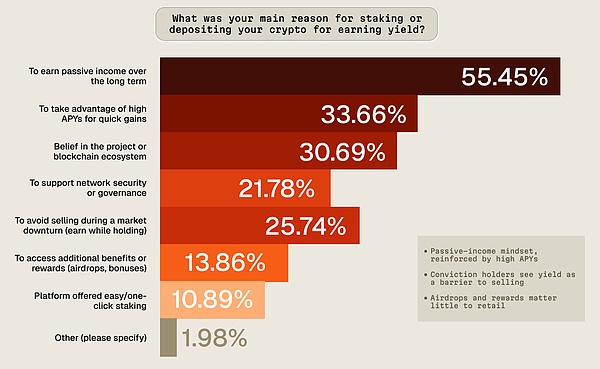
2.4 Preferred income platform
When retail investors make profits, they almost always put their funds on centralized exchanges (47.2%); second is the “consumer-level” financial management app with its own wallet function (22.77%), while the proportion of direct interaction with DeFi is very small (5.94%); about a quarter of the respondents have never participated in any interest-earning products (23.76%).
The core of this phenomenon is not just “who gives the higher interest rate”, but “where the users are”:
-
Trust and accountability: Familiar big brands, customer service hotlines, reserve certificates, and one-click export of 1099/tax forms make novices feel that “anything goes wrong”.
-
Usage threshold and experience: You can log in with one account and password; legal currency deposits, withdrawals, transactions, and interest generation can be completed in one stop; there is no need to install an on-chain wallet, copy mnemonic phrases, or worry about gas, bridging, and slippage.
-
The income is predictable: “Annualized 6.5%” is directly written on the page, and it also provides a “deposit and withdraw” or “automatic earning of coins” switch; compared to DeFi’s real-time floating APY and governance token rewards, it is simpler and safer.
-
Default path dependence: The assets are already on the exchange, just click “Earn”, and the transfer cost is almost zero.
-
Difference in risk perception: Smart contract vulnerabilities sound “far away from me”, but the custody responsibility of “if you transfer the wrong address and you will lose it forever” is extremely specific – so users simply hand over their private keys to the platform.
Conclusion: Although DeFi is far ahead in innovation and combinatoriality, the mainstream retail crowd is still stuck in the closed exchange loop of “transaction is income, income is interest earning”.The above findings are also consistent with the first part of the “market size” estimate – active users of CEX yield products are an order of magnitude higher than DeFi.
2.5 Three major obstacles to not participating in income-generating products
-
Liquidity concerns: Being available at any time is a hard requirement.Any “lock-up” prompt will remind ordinary investors that they cannot stop losses under extreme market conditions, so they will directly avoid it.
-
Questions about safety: News about platforms running away and projects experiencing thunderstorms have strengthened the impression of “high returns = high risks”.For most people, evaporation of principal is more terrifying than low returns.
-
Understanding threshold: Concepts such as pledge, on-chain contract, impermanent loss, and slashing are obscure and difficult to understand.Once the information exceeds the cognitive comfort zone, the default decision is “don’t touch”.
Conclusion: What hinders the popularity of income is not “not wanting interest”, but “fear of not getting it back, fear of unreliable platform, fear of not understanding”.Only by making the product as easy to deposit and withdraw as a current deposit, as endorsed by a brand as a bank, and as understandable at a glance as Yu’E Bao, will retail funds truly flow in.
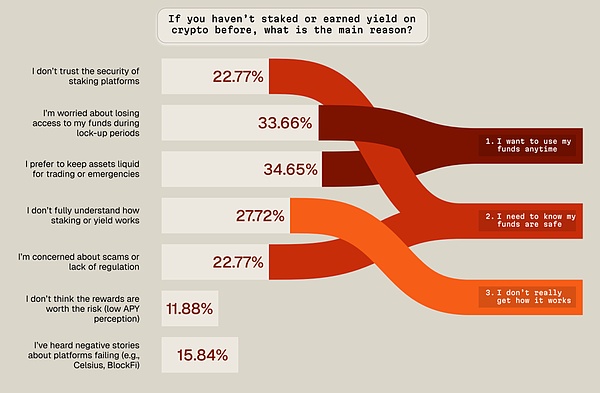
2.6 Word choice to describe “crypto earnings”
Language determines the threshold of understanding.When the retail investors interviewed were asked which statement was easiest to understand, the overwhelming winner was: “earning interest on your crypto.” – It directly benchmarks bank savings and requires no additional technical background.
The second-ranked expression is: “Passive income from cryptocurrencies.” It also borrows traditional financial concepts to make income a living.On the contrary, jargon such as “staking, yielding, farming” has almost no interest among mainstream users.These terms are common in the crypto-native community, but they only create a sense of distance for laypeople.
Conclusion: To drive retail adoption, benefits must be packaged into everyday financial language that can be “understood and remembered” – making people understand first, then reassure them, and finally get people to invest money.
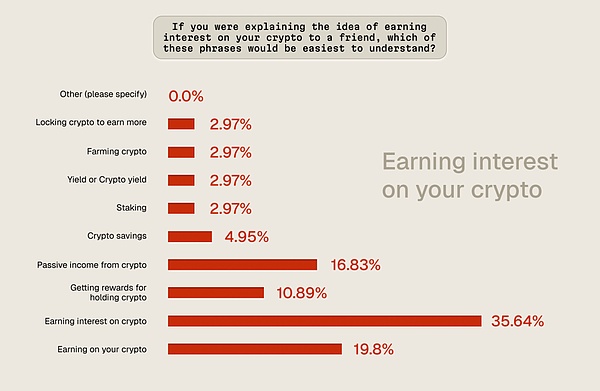
2.7 The “minimum annualized rate” that retail investors are willing to tempt
1–2% is almost ignored, and 3–5% generates little interest – even if it is higher than bank deposits or government bonds.For most retail currency holders,6% is a hard threshold: Only by reaching or exceeding this number will the gains be worth moving their assets from the spot wallet to the “coin earning” account.
The logic is simple:Cryptocurrency itself is already a high-risk asset, and returns are treated as a “risk premium” rather than solid interest..What users have in mind is not necessarily safety and sustainability, but “crypto should give more attractive returns.”This also explains why those “limited-time high interest rates” that frequently cost more than ten or twenty points can still attract attention instantly even if they only last for a few days: they are in line with the public’s expectation that “the currency circle should be more profitable.”
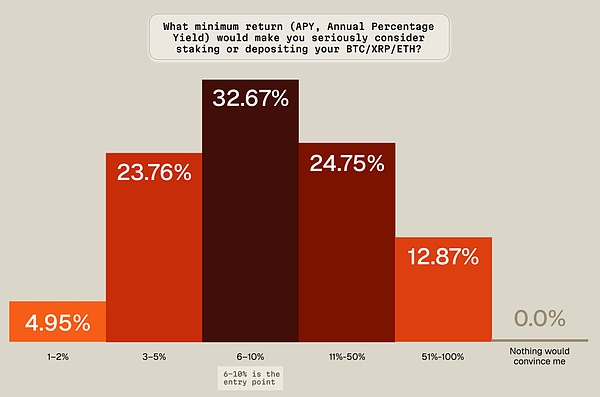
2.8 Why we are afraid of “profit”
In the eyes of retail investors, the biggest risk of income products is not “low interest rates”, but “lost principal” or “not being able to get it back when needed.”The specific performance is:
-
The platform suddenly went bankrupt and ran away;
-
Being hacked or the contract being attacked;
-
Smart contract vulnerabilities cause funds to evaporate;
-
The lock-up clause turns the redemption button “grey”, and you can only stare blankly when the market plummets.
They are not indifferent to the benefits;It’s about being unable to be sure “whether the money is safe and whether you can withdraw at any time.”.Therefore, to expand the audience, platforms must compete by putting “trust, transparency, and liquidity” before profitability.
If you want to win the hearts of retail investors, first show these three cards:
-
Reserve certificates are issued regularly, and client assets are completely isolated from company funds;
-
The redemption rules are clear at a glance – “How long does it take to receive the account, whether it is T+0, and whether there is any early unfreezing fee” are clearly written;
-
Talk about risks in plain language: Don’t shy away from “possible loss of principal in extreme circumstances” and don’t use “code is law” as a shield.
Only when people are reassured first and then tempted can the income market truly break out of the circle.
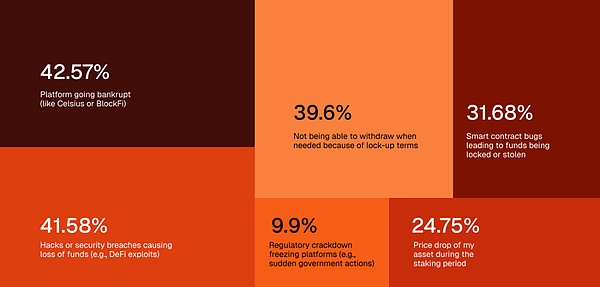
2.9 Drivers of retail adoption
In the crypto market, which often fluctuates by 10%, what can best attract users first is not high APY, but high APY.“Leave if you want”.Instant, lock-free redemption gives investors reassurance: if the market changes or money is needed temporarily, they can withdraw it to the spot wallet with one click – the control is always in their hands.
This also explains why exchanges are currently far ahead: they put “Liquidity + Security“The two signals are placed in the most prominent position, making the rate of return look like “icing on the cake” rather than “risk compensation.”
Implications for product managers and marketers:
-
First prove that users can withdraw at any time;
-
Re-certify that the funds are protected (certificate of reserves, insurance, compliance custody);
-
Finally, the attractive interest rates were revealed.
Points, airdrops, multi-level rewards and other fancy gameplay can only play a decorative role on this “foundation”, otherwise no matter how high the annual growth rate is, it will not retain people.
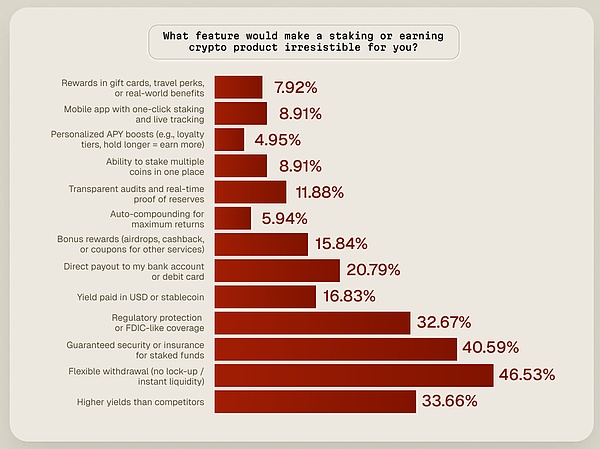
3. Conclusion
The crypto income market in 2025 presents a “dual-track reality”:
-
One is a huge centralized track – tens of millions of retail investors steadily receive interest through the custody platform;
-
The other is a small decentralized track – only a few hundred thousand geeks “work on their own” on the chain.
Retail investors are still cautious: they require withdrawals at any time, higher returns than traditional financial management, and put safety before returns.Most people are indifferent to single-digit APY, and above 6% is worth moving money.
The stumbling blocks are always “trust” and “access”: fear of thunderstorms on the platform, fear of hackers, fear of lock-up, and fear of not understanding the rules.To grow in volume, products must rank liquidity, transparency, and simplicity before yield.
Language is also crucial – “staking” and “Yield Farming” make people stay away, but “earning interest with cryptocurrency” can be understood in seconds.Mainstream popularization must rely on familiarity first, and then talk about innovation.
Looking to the next step, the winner will not be the player with the highest APY, but the player with the smoothest experience, clearest protection, credible returns, and ready access.The retail torrent of crypto income does not rely on hard push with high interest rates, but relies on “understanding, withdrawing quickly, and sleeping” to win trust.






